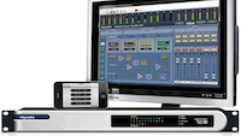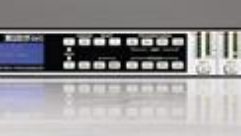
Symetrix Zone Mix 760
Feb 1, 2008 12:00 PM,
By John McJunkin
Clean and simple zone mixer saves time and money.

The Zone Mix 760 is the first product in the Symetrix Integrator series, and it is a zone mixer intended for use in restaurants, sports bars, fitness clubs, night clubs, hotels, retail outlets, casinos, and other such applications. But it’s much more than just a mixer. It sports some pretty formidable digital signal processing, it is easily configured and controlled by computer software, and it can be networked. I test drove a Zone Mix 760 — along with one of Symetrix’s ARC-2 remote-control wall panels — and I was quite pleased with the system.
The front panel of the Zone Mix 760 has nothing but display LEDs — no controls whatsoever, with the notion of making the device tamper-proof. The system’s initial configuration is handled strictly by the system integrator via a computer. The front panel features just LED indicators associated with the unit’s four mic/line inputs; eight audio media (RCA) inputs; six outputs; and power, network, and ARC connectivity. The 760’s manual refers to the level-oriented LEDs as bicolor, but they are actually tricolor — indicating signal presence with green, moderate levels as amber, and clipping levels as red.
From left to right across the rear panel of the Zone Mix 760, you’ll first find an IEC AC power input, which Symetrix smartly enabled to operate from 100V to 240V and at either 50Hz or 60Hz — making it usable nearly anywhere in the world. Next up are two 3-pin Euroblock connectors, called EXT CTRL 1 and 2. These facilitate the use of 10K linear-taper potentiometers or contact-closure controls for muting or selecting presets. Each external control port features an LED that illuminates when potentiometer mode is selected and extinguishes when contact mode is selected. Below the two external control ports are two RJ-45 jacks, separated by a single 3-pin Euroblock port. The left RJ-45 is exclusively for the connection of a Symetrix ARC controller (or multiple daisy-chained units). The right RJ-45 is for Ethernet connectivity with a computer or a third-party device, and the Euroblock is an RS-485 port for connection to RS-485 controllers. To the immediate right of these ports is a row of six 3-pin Euroblocks, representing the system’s balanced line-level outputs. Above this strip is the unit’s 9-pin RS-232 connector. Next on the right are eight pairs of RCA inputs — the 760’s audio media inputs. These are internally summed to mono, but they are provided to introduce both stereo channels. Finally, on the far right are four 3-pin Euroblock connectors representing the unit’s mic/line inputs, which facilitate five discrete input levels and provide phantom power.
Obviously, the principal functions of the Zone Mix 760 are signal management and processing, and I found the device executed both tasks handily. The systems contractor handles the initial configuration of signal-routing and processor settings, but the Zone Mix 760 computer software enables other authorized users to make tweaks as necessary. This software simplifies the entire process with wizards for connection, I/O labeling, and external controller setup. The graphical user interface is quasi-photorealistic, making adjustments easy for anyone familiar with audio hardware. Each of the four mic/line inputs has a number of input-stage-oriented controls, including digital trim and polarity inversion. Each also features a noise generator that is capable of creating white or pink noise — handy for tuning the system in each zone. There are five bands of equalization on each input (low and high shelf-type and low-,mid-, and high-parametric bands). Each also has a rumble (high-pass) filter, sweepable from 20Hz to 200Hz. Each mic/line input has a nicely appointed compressor with controls for threshold, ratio (from 1:1 to 20:1), attack, release, and make-up gain. Three knee settings are available: soft, medium, and hard. Each input also sports a sophisticated 8-band, feedback-suppression processor with well-planned presets and parametric control of notch depth and width, along with threshold and sensitivity and a panic limiter.
The audio media inputs have simpler but welcome DSP, too — digital trim and automatic gain control with a single target output level control. The system’s outputs have very useful loudspeaker-management DSP, specifically eight-band fully parametric EQ, HPF, and LPF — with selectable topology (Butterworth, Bessel, and Linkwitz-Riley) and selectable slopes from 6dB/octave to48dB/octave. A digital delay of up to 341 milliseconds is also available on each output, as well as a limiter with threshold and release controls.
The software’s graphical user interface provides constant metering for all inputs and outputs, and in addition to displaying all aforementioned DSP information, it also facilitates control and monitoring of each of six zones. This control facilitates multilevel ducking and prioritization. Another feature that I really like is the inclusion of ambient sensing control of SPL, with some pretty sophisticated parametric controls — obviously including minimum and maximum gain, but also gain/sense ratio and speed. It also tracks sense statistics, providing valuable information to the system operator. The software also displays an output RTE matrix, which shows routing from zone to physical output. The software can also configure signal routing from each of three page stations.
I had no difficulty whatsoever connecting and configuring the system, including an ARC-2 remote-control unit. The software wizards vastly simplified the process of establishing network connections with my computer and with the ARC-2. The labeling wizard enabled me to establish labels for all inputs, outputs, zones, and page stations in just a couple of minutes. Once the labels were established, it was vastly easier to visualize signal flow — although mental visualization is not necessary because the software displays precisely where every signal comes from and where it’s going. In particular, the zone-sources page displays nodes in the signal flow — which, when clicked, open the control-interface page associated with them (i.e. duckers, SPL sensing, and output routing). This is a clean, neat, and well-planned graphical user interface.
Audio passed through the system sounds great, and all EQs and dynamic processors use quality algorithms. Speaking of passing audio, one feature that I particularly liked was the capacity to send audio over the Cat-5 cables used for connection with ARC-control units. There are obviously going to be some limitations to this, but I still found it very powerful. Symetrix makes multiple ARC controllers available, ranging from simple to complex. I got to play with the ARC-2, which is the most sophisticated of the bunch. The ARC-2 is a single-gang, three-button device with a very welcome eight-character alphanumeric display. It’s powerful and aesthetically pleasing, and it is very easily named and programmed for no-muss, no-fuss operation via the external-controller wizard in the software.
The Symetrix Zone Mix 760 is a powerful zone mixer and signal-management tool. I have used a number of Symetrix products over the years, all of which have sounded great, and this unit is no exception. Considering its capacity to route audio over Cat-5, formidable DSP, ultra-simple operation, and reasonable price, I would strongly recommend it.
PRODUCT SUMMARY
Company: Symetrix
www.symetrixaudio.com
Product: Zone Mix 760
Pros: Audio over Cat-5 control cable, solid DSP.
Cons: Software not yet compatible with Microsoft Vista.
Applications: Paging and music-management zone mixer.
Price: $1,499
SPECIFICATIONS
Sampling rate: 48kHz, ±100ppm
Frequency response: 20Hz to 20kHz, ±0.5dB
Dynamic range: >105dB (A-weighted)
Total THD+Noise: 90dB typical at +4dBu, 1kHz, 0dB gain
Input impedance: 6.67kΩ, balanced
Output impedance: 200Ω balanced, 100Ω unbalanced
Maximum input level: +24dBu mic/line, +8dBV RCA
Maximum output level: +24dBu, 100k (typical)
Mic preamp EIN: >-127dB, 22Hz to 22kHz, 100 source impedance
Mic/line gain: 0dB to 54dB
Phantom power: +20VDC
Input CMRR: >40dB, typical >50dB @ 1kHz
Interchannel crosstalk: >-80dB typical
John McJunkinis the principal of Avalon Podcasting in Chandler, Ariz. He has consulted in the development of studios and installations and provides high-quality podcast-production services.









